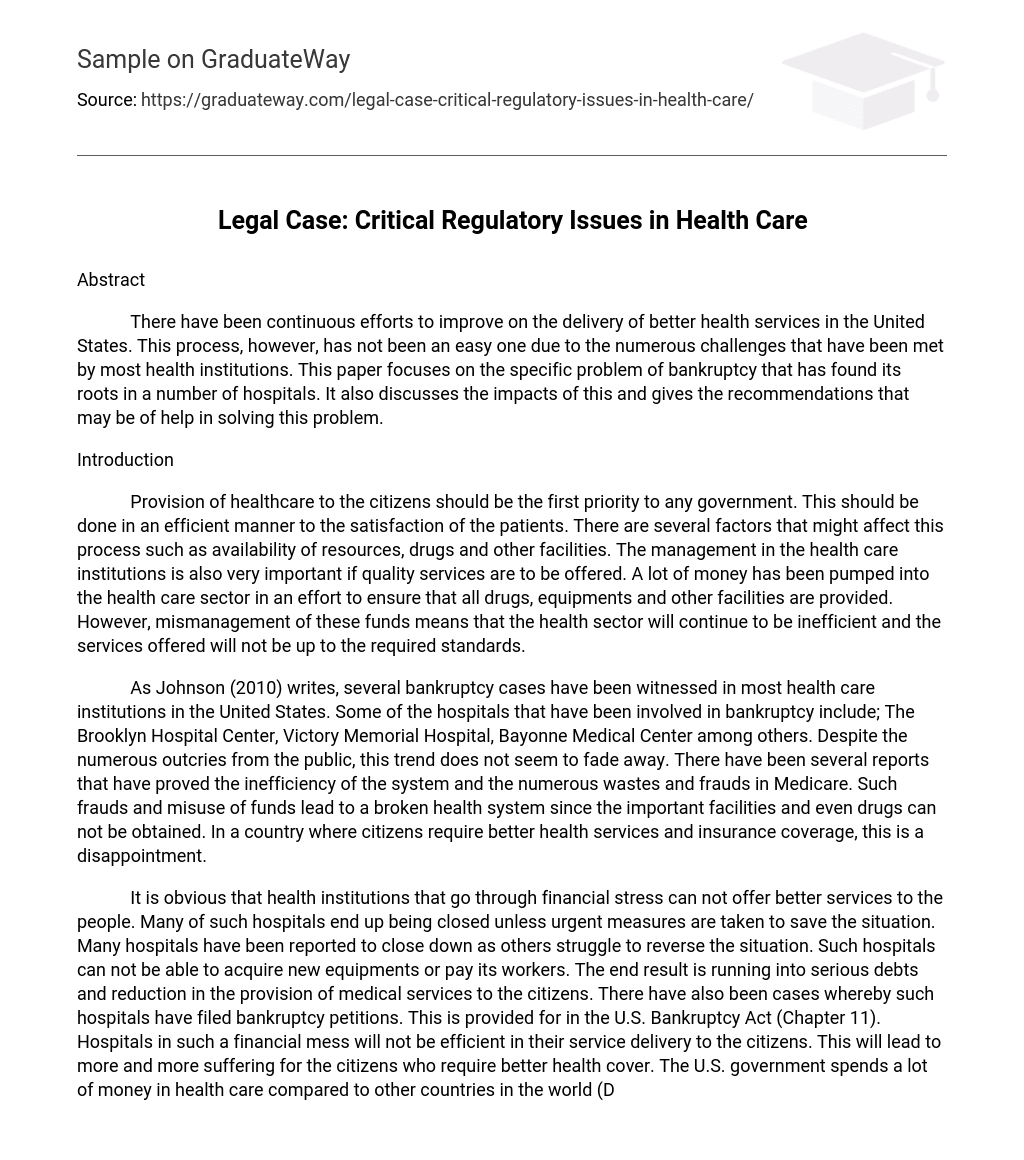Abstract
There have been continuous efforts to improve on the delivery of better health services in the United States. This process, however, has not been an easy one due to the numerous challenges that have been met by most health institutions. This paper focuses on the specific problem of bankruptcy that has found its roots in a number of hospitals. It also discusses the impacts of this and gives the recommendations that may be of help in solving this problem.
Introduction
Provision of healthcare to the citizens should be the first priority to any government. This should be done in an efficient manner to the satisfaction of the patients. There are several factors that might affect this process such as availability of resources, drugs and other facilities. The management in the health care institutions is also very important if quality services are to be offered. A lot of money has been pumped into the health care sector in an effort to ensure that all drugs, equipments and other facilities are provided. However, mismanagement of these funds means that the health sector will continue to be inefficient and the services offered will not be up to the required standards.
As Johnson (2010) writes, several bankruptcy cases have been witnessed in most health care institutions in the United States. Some of the hospitals that have been involved in bankruptcy include; The Brooklyn Hospital Center, Victory Memorial Hospital, Bayonne Medical Center among others. Despite the numerous outcries from the public, this trend does not seem to fade away. There have been several reports that have proved the inefficiency of the system and the numerous wastes and frauds in Medicare. Such frauds and misuse of funds lead to a broken health system since the important facilities and even drugs can not be obtained. In a country where citizens require better health services and insurance coverage, this is a disappointment.
It is obvious that health institutions that go through financial stress can not offer better services to the people. Many of such hospitals end up being closed unless urgent measures are taken to save the situation. Many hospitals have been reported to close down as others struggle to reverse the situation. Such hospitals can not be able to acquire new equipments or pay its workers. The end result is running into serious debts and reduction in the provision of medical services to the citizens. There have also been cases whereby such hospitals have filed bankruptcy petitions. This is provided for in the U.S. Bankruptcy Act (Chapter 11). Hospitals in such a financial mess will not be efficient in their service delivery to the citizens. This will lead to more and more suffering for the citizens who require better health cover. The U.S. government spends a lot of money in health care compared to other countries in the world (Dimarco, 2010).
Recommendations
There is need to reduce the unnecessary expenses incurred by the hospitals. The health institution management should also be kept in close scrutiny to ensure that funds are not misappropriated. The hospitals need to reduce its operational costs and the manpower needed in service deliver. However, the reductions in staff numbers need to be done in an appropriate manner. There is need to recruit competent staff as this will reflect on the quality of the service delivered. There have also been reports of widespread corruption involving workers in the health institutions. Most of them have been reported to get illegal cash. This is a big set back in the realization of equitable distribution of health services. Therefore, there is need for reforms in the health institutions to ensure accountability. This will ensure efficiency in the delivery of services, improvement in the quality of the services and equitable distribution of health care to all. The government should also finance hospitals which might suffer financial problems so that they do not close down (Dimarco, 2010). Therefore, the health care system needs to be regulated and monitored to ensure accountability and continuous provision of better health services.
References
Dimarco, J.M. (2010). Health Care Industry: Turning around financially distressed hospitals. Retrieved on 8th May, 2010 from http://findarticles.com/p/articles/mi_m3257/is_n5_v44/ai_8983179/pg_2/?tag=content;co l1
Johnson, J.R. (May 2007).Issues in Health Care Bankruptcy Cases. Retrieved on 8th May, 2010 from http://www.dlapiper.com/health_care_bankruptcy_issues/.





